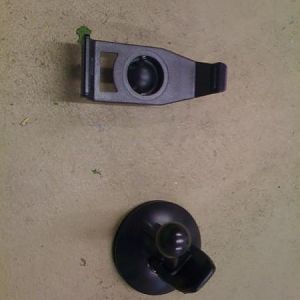roadrunner
Full Access Member
I decided to replace the plugs at 22k miles -- thought I'd try some of those iridiums to see if they made a difference, as some claim.
The first surprise is that the original plugs had already eroded from the factory setting of 44/1000" to 54 - 57/1000" That's a lot of wear considering the factory recommend change is at 30k miles. Glad I didn't wait.
So what difference did the new plugs make? Mostly none. No change in idle speed, no change in gas mileage (using known routes and apeeds). The one exception is performance under load. My "instant MPG" consistantly improved from 7/8MPG to 8/9MPG coming up the one mile stretch of 14% grade on my street. That's better than 10%!
This is consistant with a couple of explanations. Spark demand is known to be greatest under heavy load. Apparently with the Liberty, a plug gap increase of 10/1000" becomes signigicant under load, but not under normal driving conditions.
As for the NGK iridium plugs: They offer no advantage or disadvantage in spark quality over platinum or standard plugs. As with all new plugs, however, they RESTORE any lost performance from your old plugs. Fine wire iridium and platinum offer two advantages over standard plugs. 1) they hold their gap much longer than standard plugs, so you'll get proper performance longer and don't have to change plugs as often; and 2) they take less energy to fire, offering some forgiveness for a worn ingition system.
Other trivia: most plugs, regardless of type, use a copper core. The reason for iridium is simply that it wears better than platinim. The reason for platinum is that it wears better than steel. Iridium/platinum is placed on the tip of the center electrode. All "fine wire" plugs require less voltage to fire, explaining the forgiveness factor mentioned above. "Double" platinum and some iridiums have (in addition) a platinum plating on the outside or ground electrode. This extends the plug life more and usually costs more. Prices vary considerably, usually dependent on the amount of platinum/iridium used. It's expensive stuff. They are definitely not all the same. I also noticed the NGK were all properly gapped within 1/1000; Autolite iridiums (just installed on my Ford Ranger) were all incorrectly set and needed to be regapped (this may not be a valid comparison since the application differed, but it was annoying). NGK is also the OE brand. I've used them for years and heartedly recommend them -- no problems with binding, broken tips, etc. etc.
Whatever brand/style of plugs suit your fancy, it may be a good idea to change them early for optimim performance, especially if you do a lot of towing or mountain driving, or you just want to keep your Liberty in peak condition! \ /
/
The first surprise is that the original plugs had already eroded from the factory setting of 44/1000" to 54 - 57/1000" That's a lot of wear considering the factory recommend change is at 30k miles. Glad I didn't wait.
So what difference did the new plugs make? Mostly none. No change in idle speed, no change in gas mileage (using known routes and apeeds). The one exception is performance under load. My "instant MPG" consistantly improved from 7/8MPG to 8/9MPG coming up the one mile stretch of 14% grade on my street. That's better than 10%!
This is consistant with a couple of explanations. Spark demand is known to be greatest under heavy load. Apparently with the Liberty, a plug gap increase of 10/1000" becomes signigicant under load, but not under normal driving conditions.
As for the NGK iridium plugs: They offer no advantage or disadvantage in spark quality over platinum or standard plugs. As with all new plugs, however, they RESTORE any lost performance from your old plugs. Fine wire iridium and platinum offer two advantages over standard plugs. 1) they hold their gap much longer than standard plugs, so you'll get proper performance longer and don't have to change plugs as often; and 2) they take less energy to fire, offering some forgiveness for a worn ingition system.
Other trivia: most plugs, regardless of type, use a copper core. The reason for iridium is simply that it wears better than platinim. The reason for platinum is that it wears better than steel. Iridium/platinum is placed on the tip of the center electrode. All "fine wire" plugs require less voltage to fire, explaining the forgiveness factor mentioned above. "Double" platinum and some iridiums have (in addition) a platinum plating on the outside or ground electrode. This extends the plug life more and usually costs more. Prices vary considerably, usually dependent on the amount of platinum/iridium used. It's expensive stuff. They are definitely not all the same. I also noticed the NGK were all properly gapped within 1/1000; Autolite iridiums (just installed on my Ford Ranger) were all incorrectly set and needed to be regapped (this may not be a valid comparison since the application differed, but it was annoying). NGK is also the OE brand. I've used them for years and heartedly recommend them -- no problems with binding, broken tips, etc. etc.
Whatever brand/style of plugs suit your fancy, it may be a good idea to change them early for optimim performance, especially if you do a lot of towing or mountain driving, or you just want to keep your Liberty in peak condition! \










